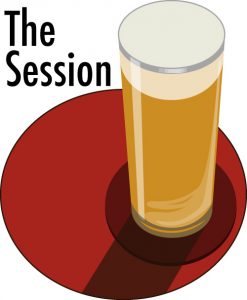This is my contribution to session 125, aka “Beer Blogging Friday”. In this session, I’m writing about my views about SMaSH beers.
SMaSH beers are a way of formulating beer recipes. SMaSH stands for “single malt and single hop”, meaning that in the formulation of the recipe only a single type of malt (usually a base malt of some sorts) of a single hop variety are being used. Everything else, from yeast to mashing regime to hop dosages and timing, is up to the brewer.
Would I consider SMaSH beers to be trendy? No, not at all. The only reason that I can see in purposefully producing a SMaSH is to try out a specific ingredient, be it a specific base malt, a new hop variety, or even a new yeast strain on top of a simple, neutral SMaSH wort. While certainly a great tool for homebrewers for learning to know ingredients, I personally find them boring and uninspired. In particular when commercial brewers produce them: it reeks of beer geekery, it will not impress people with no interest in the finer details of brewing, and more often than not, the resulting beer is unbalanced.
Don’t get me wrong: there are beers and whole styles that happen to be SMaSH beers, but they were not conceived with the specific idea of producing a beer to highlight one type of malt and one hop. From a purely historic point of view, most beers were probably SMaSH beers: the maltster made one type of malt, the brewer took that one malt and used the local hops he always used for brewing, and made beer out of that. Modern base malt names like Pilsner malt, Vienna malt, and Munich malt show this historic connection with classic styles.
Of course, there are many ways to formulate recipes for styles like Bohemian-style pale lager, Vienna lager, Munich Helles or Munich Dunkles. But for each of these classic lager styles, there is a straightforward way that happens to be SMaSH.
For a Bohemian-style pale lager, like a Pilsner, you can just use 100 % Pilsner malt to an OG that is suitable for the strength you want to achieve, hop it with large doses of a hop variety like Saaz for both bitterness and aroma, and ferment with a lager yeast.
Vienna lager? Similar: 100 % Vienna malt, bittering with a classic hop like a Bavarian noble hop variety or Saaz, ferment with a lager yeast. And the same goes for the Munich beer styles: depending on whether you want it pale or dark (Helles or Dunkles), choose a pale or dark base malt, hop with some Bavarian noble hop for only a restrained bitterness, and ferment with a lager yeast.
Of course, this goes beyond classic lager styles: beers like pale ales, IPAs, golden ales, bitters, or saisons could easily be formulated with just a single base malt and just one hop variety. Even a relatively unknown style, Grätzer/Piwo Grodziskie, was/is usually brewed with a single malt: oak-smoked wheat malt. There are probably plenty of many more examples.
Other beer styles can practically not be achieved as a SMaSH, in particular those who require more than one type of grain: just think Bavarian wheat beer, which needs to be brewed with more than 50 % wheat malt, but usually also contains a certain share of barley malt. Dre Beechum suggested an interesting extension to SMaSH, “brewing on the ones“, that only slightly widens the constraints of SMaSH, but allows for more existing styles to be formulated easily. I wrote about this in the context of designing simple beer recipes a few years ago.
But still, I’m convinced that SMaSH or “brewing on the ones” beers should not be done just for the sake of strictly keeping to this scheme of recipe formulation, but rather as a rough guideline to formulate simple recipes in order to brew excellent beers. After all, the resulting beer is what counts to the connoisseur, not the (by itself meaningless) notion that only one hop and only one malt type were used. If a beer can be improved by adding a single specialty malt, or by using different bittering hops than aroma hops, then you should totally do that, instead of insisting on conceptual purity. Because what counts in the end is that the beer is good.


I generally agree with you that, if a beer can be improved by using multiple malts or hops, do so. But I also appreciate the opportunity to have the malt/hops on their own so I, a drinker and not a brewer, can find out what they taste like. I can then take this knowledge with me and better appreciate beers that includes these ingredients along with others.
As a fan of rauchbier I have been trying to learn what the various woods used to smoke the malt contribute to the taste. Similarly, a brewery here (Wisconsin, USA) made a SMaSH beer using Marris Otter. Since it’s uncommon here, I appreciate the opportunity to get to know it without having to try to discern it from other malts. With hops being so popular, I think it’s easier for a non-brewer like me to get to know what a hop variety tastes and smells like as opposed to a malt variety.
SMaSH beers have their place but I wouldn’t want to drink in a world where that’s all there was.